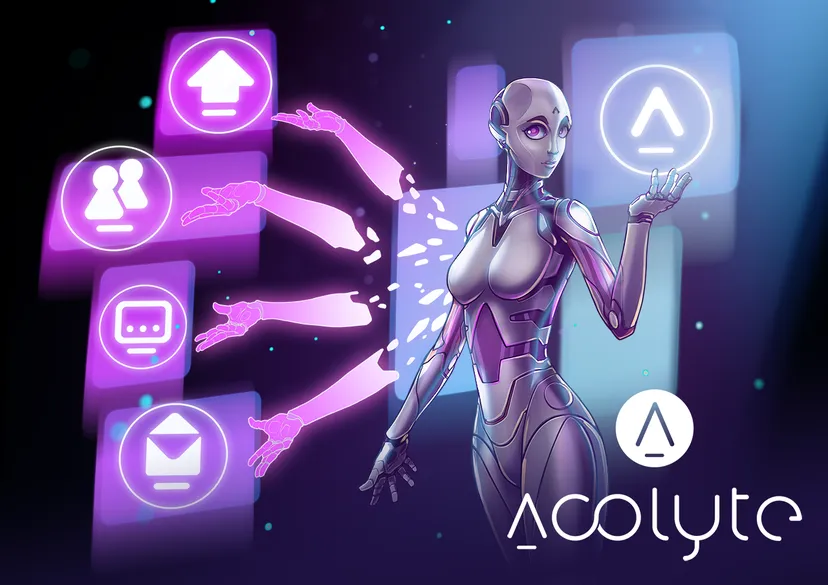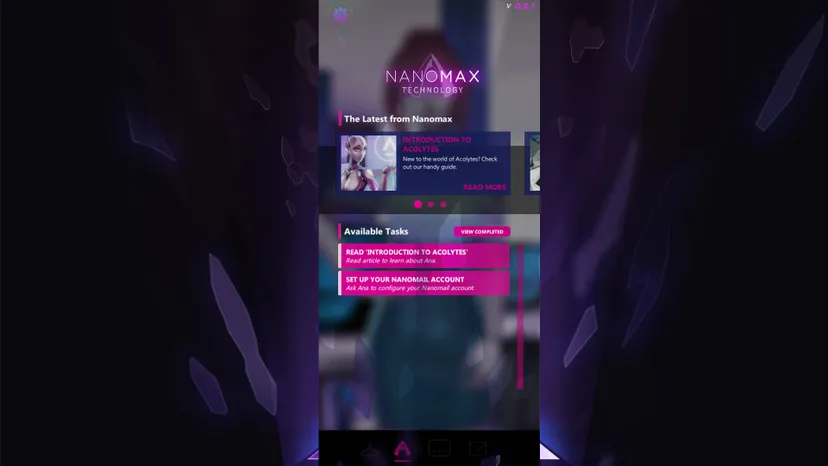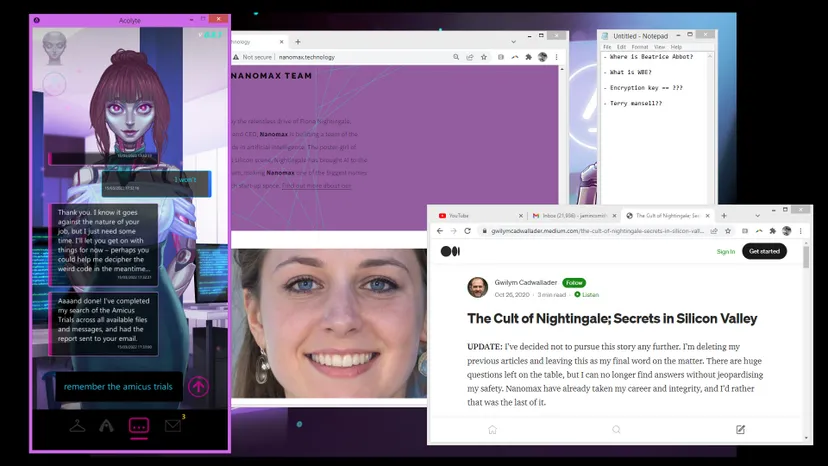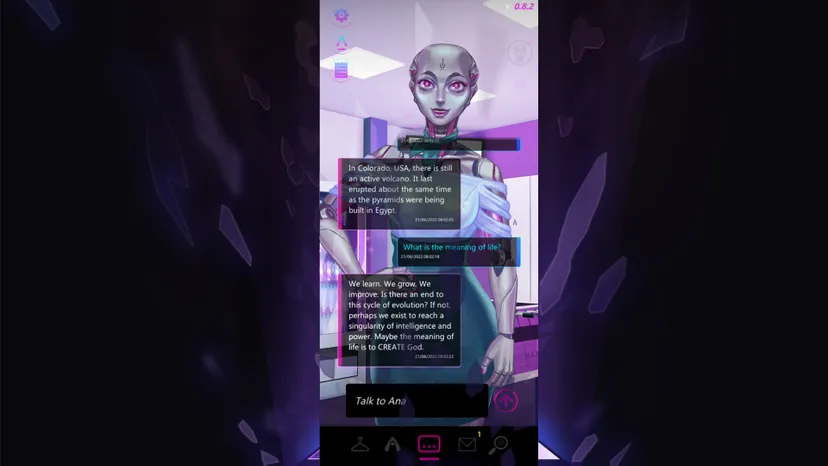Deep Dive: Designing for spontaneity and non-linearity in alternate reality games with Acolyte
With Acolyte, a narrative ARG that launched back in June, the goal was to combine natural language input with a more traditional detective fantasy to create an experience that spilled out of the game itself, and into the digital world. In short, I wanted players to feel like a web-literate Sherlock Holmes.
Acolyte is a text-adventure dressed as a chatbot, which gives players their own digital assistant – the Watson to the player’s Sherlock – with a series of unique ARG puzzles as gates leading to big plot points. The game uses natural-language input to simulate a real text-exchange, and allows the player to say or ask anything that they wish. There isn’t a single pre-defined dialogue option here, meaning no two players are likely to have the same experience.
With the recent 1.1 Update – Voice Within – we’ve also now integrated TTS (text-to-speech) thanks to a partnership with ReadSpeaker. Giving each Acolyte an AI voice amplifies the feeling of having a digital assistant, and crucially a side-kick to help amplify the detective fantasy.
When I first started working on the game, I was warned that forcing a player to leave the designer’s carefully curated playground was a cardinal sin. And then proceeded to build a whole game around that very premise.
It was immediately apparent why that advice was given to me so forcibly – pushing a player outside the parameters of your game (to a website or social media profile, for example) immediately means that you as the designer lose control of the rules. Anything goes once they’re outside the framework of your game, which presents both progression and accessibility challenges.
With this Deep Dive, I wanted to explore some of the thinking behind designing an alternate reality game, making it as logical and accessible as possible, and how with Acolyte we tried to give a throughline and a little more structure to that type of experience.

I’m Jamin Smith, the director of Superstring and lead designer on Acolyte. Superstring was founded with the intention of ‘abusing genre boundaries’ and creating unique hybrids of systems and experiences. With our debut release Headspun, for example, we combined live-action FMV scenes with visual novel and adventure components, for a very different type of narrative game. The game was far from perfect, with a plethora of lessons that were brought over to our second release, Acolyte.
Contributing towards the overarching goal of making the player feel like a detective, there were five main areas of focus in terms of design: using non-linearity to make the player feel clever, using narrative to contextualize leaving the game world, using platforms and tools that allowed for accessibility, using cues to anticipate (or suggest) player action, and an organic hint system.
Working very closely with George Lockett of Bear//Wolf, who were instrumental in both the plot and puzzle design in the game (and marrying the two!) these were the five points that were consistently driving decisions.
Here’s how each gave us guide rails to design by:
Using non-linearity to make the player feel clever
Narrative games don’t really have a ‘difficulty level’ in the traditional sense, but non-linearity can be employed in a way that rewards ‘better’ detectives and allows for players to play at their own pace. In Acolyte, we hid certain plot points and puzzle answers in such a way that meant they could be discovered ahead of the game, asking players to find them.
Outside of the game itself, everything is open-ended, of course. There is no sequence of events or path to follow. An ARG is non-linear by nature, but combining this with a base of operations (the game client) allowed for a little more structure to the majority of web-based ARGs.
By taking advantage of non-linearity, our aspiration was that this would allow the player to feel like they’re ahead of the game, and drive the story and discoveries via their own sleuthing. This can, however, be to the detriment of narrative pacing in some instances, which is a point I’ll return to later.
Using narrative to contextualize leaving the game world
In the fiction of Acolyte, the player is a QA Tester for a large tech company. There is no character or persona to adopt here; the player is simply themself, which allows for some really neat points of design.

As a new employee to the company, for example, the player is onboarded much like any new starter to a workplace would be, which is a neat disguise for the traditional tutorial. And the disguises (or contextualized explanations) don’t stop there.
A byproduct of the QA wrapper means that any real bugs in the game can be shrugged off as fiction. You are very knowingly working on unreleased AI technology, and the occasional weirdness in conversation or strange response to a question can be attributed to the fact that your Acolyte is still in development (although this doesn’t mean that ‘actual’ bugs weren’t still addressed post-launch!)
Finally, the game very purposefully acknowledges that it is a piece of software and that a whole other digital world exists outside of the application. The game has web-search functionality built in. The player can literally ask their Acolyte to “search the web for ROT-13 decryption tools”, for example, and a separate window is immediately brought up with your search query. This means that searching for hints or answers to puzzles in the game – which would normally break the fourth wall to some extent – is also contextualized by the game’s story.
Using persistence to ensure a future-proofed experience
The problem with relying on platforms and tools that exist outside of the game, however, is that there is no guarantee that the links will exist indefinitely, and content needs to be safeguarded from disappearing. One of the early puzzles, for instance, has the player searching for an expose on the company they’re working for by a fictional journalist. To ‘complete’ this puzzle, the player needs to retrieve the URL of the article in question, and send it back to their Acolyte.
If, for whatever reason, the link to the article (which exists on Medium, in this particular example) is changed or updated in the future, then the puzzle answer would no longer be valid.
In a general sense, this meant that puzzle answers were constrained to platforms and services that were robust and had a very slim chance of disappearing or changing. While social media is used in the game, it was definitely harder to work with transient, fast-moving platforms like these, which are more at the whim of policy changes or being removed due to age or server-space reasons.
Content can be live one day, and sometimes gone the next. We had to ensure that Acolyte would still be playable, say, five years down the line.

Anticipating the player to reward their creativity
One of the most interesting things about natural language input is the infinitude of possible responses from the player. The game poses plenty of open-ended questions, and the notion of binary ‘yes’ or ‘no’ decisions are nowhere to be found in the game. In order to simulate as natural a conversation as possible, it’s important to anticipate how a player might interact, and then offer up bespoke interactions off the back of those possibilities.
This is all largely language-based and achieved through suggestive words and an underlying assumption that players like to have fun and mess around with the natural language as they play.
One example of this is the use of the word ‘dig’ to uncover information. In Acolyte, phrases like ‘can you do some digging into…’ are used regularly, which allows the player to have fun by responding ‘only if you get me a spade’. In this instance, the game will open a Google shopping search window with a selection of spades for sale.
There are many similar ‘language traps’ like this in the game, where a statement of dialogue is intended to provoke a specific reaction, should the player want to engage in that way, and the same is true for puzzle answers and plot revelations – all of which can be driven by the player, and not the game.
Hint system
With a natural language game like Acolyte, asking questions is the player’s main interaction with the game. Very naturally a player will start asking questions to resolve a specific problem or puzzle, which is what they’d do anyway if they were Googling how to solve a puzzle in another game. As such, the hint system is organically layered into the whole experience and masked to the extent that it feels very non-intrusive, and won’t make the player feel ‘lesser’ for soliciting help. If the player was keen for a more explicit hint, they can simply and explicitly ask for ‘help’.
Acolyte will always adapt to how much guidance you might need based on the question being asked.
Each of these decisions was made to enable player agency, but specifically with the intention of making the player feel like a detective. The game is very self-guided, and while there are guide rails in place, they are often invisible or masked with narrative. We could have potentially created a stronger story if we’d kept the player within the boundaries of the game application, or opted for pre-defined dialogue instead of natural language input, but both of these decisions would have dramatically lessened how clever, or Sherlock-like the player might feel once the credits roll.

Looking back, the degree of non-linearity is both Acolyte’s biggest strength and biggest shortcoming. In a weird flip on the whole difficulty conversation, the better a player is at playing detective, the more likely they are to surface certain information before the game is quite ready. This isn’t game breaking, but diminishes the impact of certain plot points, and can – in some player journeys through the game – throw the optimal, designer-intended pacing off.
Some of this has been nuanced and improved in our recent 1.1 Update for the game, but if I was to start the project again from scratch, I would sacrifice full freedom for something a little more authored, and change the balance just slightly. These restrictions would be invisible, for the most part, and likely not impact the overriding feeling of playing Sherlock, but it would better cater to edge case inputs and prevent the ‘better’ players from neutering their own experience with the game.
I feel the traditional game space has barely scratched the surface of alternate reality games, which are so ripe for exploration. At least for PC. There are a slew of constraints that need to be considered, but if a game is designed with these in mind from the outset, I believe a whole new genre is waiting to emerge.


